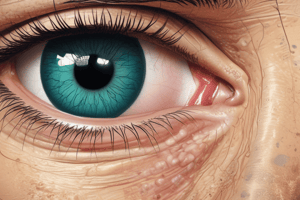Podcast
Questions and Answers
Which of the following best describes the mechanism behind psoriasis?
Which of the following best describes the mechanism behind psoriasis?
- Genetic mutation triggering cellular apoptosis
- Immune system overactivation leading to viral invasion
- Local allergic reaction to environmental allergens
- Immune dysregulation involving multiple immune cells (correct)
Which factor is NOT associated with the exacerbation of rosacea?
Which factor is NOT associated with the exacerbation of rosacea?
- Bacterial infection (correct)
- Chronic sun exposure
- Hormonal fluctuations
- Stress
What is a common clinical manifestation of contact dermatitis?
What is a common clinical manifestation of contact dermatitis?
- Dry, itchy skin with flaking
- Papules and plaques
- Erythema and pruritis (correct)
- Lichenification and scaling
Which statement is correct about bacterial skin infections?
Which statement is correct about bacterial skin infections?
Which inflammatory skin disorder is characterized by chronic, relapsing patterns and involves multiple immune interactions?
Which inflammatory skin disorder is characterized by chronic, relapsing patterns and involves multiple immune interactions?
Which of the following bacteria is a common causative agent of skin infections known for its methicillin-resistant strains?
Which of the following bacteria is a common causative agent of skin infections known for its methicillin-resistant strains?
What clinical manifestation is typically associated with folliculitis?
What clinical manifestation is typically associated with folliculitis?
Which virus is responsible for causing both chickenpox and shingles?
Which virus is responsible for causing both chickenpox and shingles?
How do tinea infections primarily transmit?
How do tinea infections primarily transmit?
Which of the following conditions is characterized by painful blisters or ulcers in the genital area?
Which of the following conditions is characterized by painful blisters or ulcers in the genital area?
Which of the following fungal infections is caused by Candida albicans?
Which of the following fungal infections is caused by Candida albicans?
What is a common clinical manifestation of impetigo?
What is a common clinical manifestation of impetigo?
What virus is primarily responsible for causing warts?
What virus is primarily responsible for causing warts?
What type of dermatitis is characterized by a delayed hypersensitivity reaction to an allergen?
What type of dermatitis is characterized by a delayed hypersensitivity reaction to an allergen?
Which of the following is NOT a common irritant that causes irritant contact dermatitis?
Which of the following is NOT a common irritant that causes irritant contact dermatitis?
What is an example of a condition caused by excessive collagen formation during the healing process?
What is an example of a condition caused by excessive collagen formation during the healing process?
Which skin condition is commonly associated with a family history of atopic conditions?
Which skin condition is commonly associated with a family history of atopic conditions?
Which of the following descriptors best fits lichenification?
Which of the following descriptors best fits lichenification?
Which inflammatory skin disorder is characterized by dry, itchy skin but is not fully understood in terms of its cause?
Which inflammatory skin disorder is characterized by dry, itchy skin but is not fully understood in terms of its cause?
Which type of skin disorder includes conditions such as eczema and dermatitis?
Which type of skin disorder includes conditions such as eczema and dermatitis?
Which skin condition may arise from the linear crack or break extending from the epidermis to the dermis?
Which skin condition may arise from the linear crack or break extending from the epidermis to the dermis?
What type of skin reaction is caused by the direct cytotoxic action of a substance on the skin?
What type of skin reaction is caused by the direct cytotoxic action of a substance on the skin?
What characterizes atrophy in the context of skin conditions?
What characterizes atrophy in the context of skin conditions?
Which skin infection is most commonly associated with pustular lesions?
Which skin infection is most commonly associated with pustular lesions?
Which type of primary lesion is represented by elevated, fluid-filled lesions less than 1 cm in diameter?
Which type of primary lesion is represented by elevated, fluid-filled lesions less than 1 cm in diameter?
What characterizes a plaque in terms of size and surface attributes?
What characterizes a plaque in terms of size and surface attributes?
Which of the following lesions results directly from scratching a primary skin lesion?
Which of the following lesions results directly from scratching a primary skin lesion?
In which type of skin cancer is early detection highly critical for successful treatment?
In which type of skin cancer is early detection highly critical for successful treatment?
What clinical manifestation is associated with Tinea capitis?
What clinical manifestation is associated with Tinea capitis?
Which of the following conditions is characterized by scaling of the skin?
Which of the following conditions is characterized by scaling of the skin?
Which statement is true regarding actinic keratosis (AK)?
Which statement is true regarding actinic keratosis (AK)?
What type of primary skin lesion is commonly involved in inflammatory skin disorders such as lichen planus?
What type of primary skin lesion is commonly involved in inflammatory skin disorders such as lichen planus?
What is the primary characteristic of basal cell carcinoma?
What is the primary characteristic of basal cell carcinoma?
Which of the following is a common clinical manifestation of Tinea pedis?
Which of the following is a common clinical manifestation of Tinea pedis?
Which skin condition can lead to secondary lesions such as ulcers due to infection?
Which skin condition can lead to secondary lesions such as ulcers due to infection?
Dysplastic nevi are more likely to develop into which type of skin cancer?
Dysplastic nevi are more likely to develop into which type of skin cancer?
What type of lesion is a cyst, and where is it typically located?
What type of lesion is a cyst, and where is it typically located?
Which secondary skin lesion is formed from the loss of both the epidermis and dermis?
Which secondary skin lesion is formed from the loss of both the epidermis and dermis?
Which of the following fungal skin infections leads to painful lesions between the toes?
Which of the following fungal skin infections leads to painful lesions between the toes?
Which condition is primarily associated with chronic exposure to UV radiation?
Which condition is primarily associated with chronic exposure to UV radiation?
Which symptom is NOT characteristic of cutaneous candidiasis?
Which symptom is NOT characteristic of cutaneous candidiasis?
What type of skin cancer is primarily caused by mutations in the TP53 gene due to UV exposure?
What type of skin cancer is primarily caused by mutations in the TP53 gene due to UV exposure?
Which of the following best describes the appearance of Tinea corporis?
Which of the following best describes the appearance of Tinea corporis?
Flashcards
Contact Dermatitis
Contact Dermatitis
A skin condition characterized by localized inflammation, redness, itching, and often blisters, triggered by direct contact with an irritant or allergen.
Atopic Dermatitis
Atopic Dermatitis
A chronic inflammatory skin condition that often manifests as dry, itchy patches, particularly in areas like the elbows, knees, and neck. It's caused by a combination of genetic factors and environmental triggers.
Psoriasis
Psoriasis
A chronic, recurring inflammatory skin disorder characterized by red, scaly patches, often on the scalp, elbows, and knees, caused by an overactive immune response.
Acne Rosacea
Acne Rosacea
Signup and view all the flashcards
Acne Vulgaris
Acne Vulgaris
Signup and view all the flashcards
Fissure
Fissure
Signup and view all the flashcards
Atrophy
Atrophy
Signup and view all the flashcards
Scar
Scar
Signup and view all the flashcards
Keloid
Keloid
Signup and view all the flashcards
Lichenification
Lichenification
Signup and view all the flashcards
Excoriation
Excoriation
Signup and view all the flashcards
Inflammatory skin disorders
Inflammatory skin disorders
Signup and view all the flashcards
Allergic contact dermatitis (ACD)
Allergic contact dermatitis (ACD)
Signup and view all the flashcards
Irritant contact dermatitis (ICD)
Irritant contact dermatitis (ICD)
Signup and view all the flashcards
Folliculitis
Folliculitis
Signup and view all the flashcards
Cellulitis
Cellulitis
Signup and view all the flashcards
Impetigo
Impetigo
Signup and view all the flashcards
Varicella-zoster virus (VZV)
Varicella-zoster virus (VZV)
Signup and view all the flashcards
Chickenpox
Chickenpox
Signup and view all the flashcards
Shingles
Shingles
Signup and view all the flashcards
Tinea infections
Tinea infections
Signup and view all the flashcards
Candidiasis
Candidiasis
Signup and view all the flashcards
Macule
Macule
Signup and view all the flashcards
Patch
Patch
Signup and view all the flashcards
Papule
Papule
Signup and view all the flashcards
Plaque
Plaque
Signup and view all the flashcards
Nodule
Nodule
Signup and view all the flashcards
Tumor
Tumor
Signup and view all the flashcards
Vesicle
Vesicle
Signup and view all the flashcards
Bulla
Bulla
Signup and view all the flashcards
Pustule
Pustule
Signup and view all the flashcards
Tinea capitis
Tinea capitis
Signup and view all the flashcards
Tinea corporis
Tinea corporis
Signup and view all the flashcards
Tinea cruris
Tinea cruris
Signup and view all the flashcards
Tinea pedis
Tinea pedis
Signup and view all the flashcards
Tinea manuum
Tinea manuum
Signup and view all the flashcards
Oral candidiasis
Oral candidiasis
Signup and view all the flashcards
Cutaneous candidiasis
Cutaneous candidiasis
Signup and view all the flashcards
Actinic keratosis
Actinic keratosis
Signup and view all the flashcards
Nevi (moles)
Nevi (moles)
Signup and view all the flashcards
Basal cell carcinoma
Basal cell carcinoma
Signup and view all the flashcards
Study Notes
Primary Skin Lesions
- Macule: A flat, discolored area less than 1 cm in diameter. Examples include freckles, petechiae, and measles.
- Patch: Similar to a macule, but larger than 1 cm. Examples include vitiligo and café au lait spots.
- Papule: An elevated, firm, circumscribed lesion less than 1 cm. Examples include warts and moles.
- Plaque: An elevated, firm, rough lesion larger than 1 cm. Examples include psoriasis and seborrheic keratosis.
- Nodule: Elevated, firm, circumscribed lesion (deeper than a papule), 1-2 cm in diameter. Examples include lipomas and erythema nodosum.
- Tumor: A solid, elevated lesion more than 2 cm, deeper than a papule. Examples include neoplasms and lipomas
- Vesicle: Elevated, fluid-filled lesion less than 1 cm. Examples include varicella (chickenpox) and herpes zoster (shingles)
- Bulla: A vesicle larger than 1 cm in diameter. Examples include blisters and pemphigus vulgaris.
- Pustule: An elevated lesion filled with pus. Examples include impetigo and acne.
- Cyst: An elevated, encapsulated lesion containing liquid or semisolid material. Examples include sebaceous cysts and cystic acne.
Secondary Skin Lesions
- Scale: Keratinized cells; flaky skin. Examples include after scarlet fever, drug reactions, and dry skin.
- Crust: Dried serum, blood, or pus.
- Erosion: Loss of epidermis. Examples include chemical injury.
- Ulcer: Loss of epidermis and dermis. Examples include pressure ulcers and stasis ulcers.
- Fissure: A linear crack or break through the epidermis to the dermis. Examples include athlete's foot, and cracks around the mouth.
- Atrophy: Thinning of the skin surface. Examples include aged skin and striae (stretch marks).
- Scar: A fibrous tissue that replaces normal skin after injury. Examples include healed wounds and surgical incisions.
Inflammatory Skin Disorders
- Contact dermatitis: Skin irritation from contact with an irritant (irritant contact dermatitis) or allergen (allergic contact dermatitis).
- Atopic dermatitis: Chronic, inflammatory skin condition characterized by dry, itchy skin, often associated with asthma and hay fever. Thought to have genetic and environmental factors.
Studying That Suits You
Use AI to generate personalized quizzes and flashcards to suit your learning preferences.




